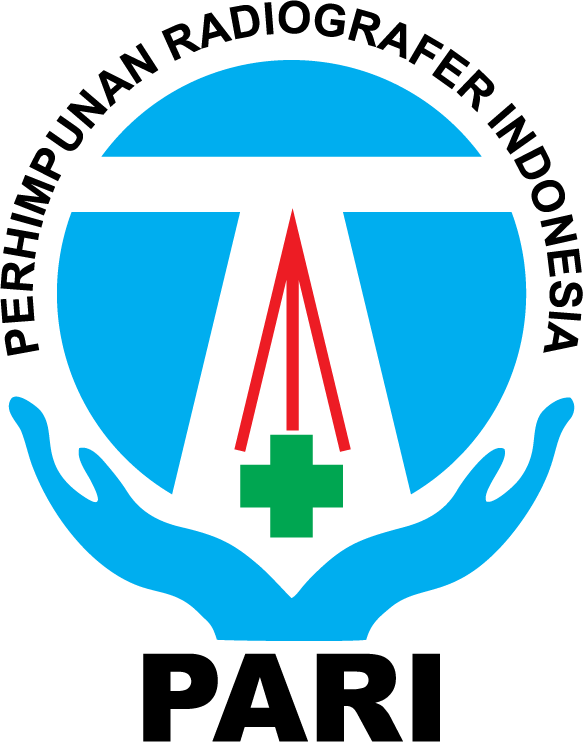Metode Penyimpanan Media Kontras Oral Nanopartikel Mangan Teh Oolong untuk Pemeriksaan Magnetic Resonance Cholangiopancreatography (MRCP)
Abstract
Background: MRCP examination using natural manganese contrast media cannot provide optimal images of gastroduodenal suppression covering the biliary system when compared with standard contrast media. Various studies on manganese contrast media have been developed, but not much has been linked to the use of natural manganese nanoparticles as an alternative contrast media. This study aims to prove that manganese nanoparticles extracted from oolong tea as an alternative oral negative contrast medium for MRCP examinations are thought to improve image quality and do not cause neurotoxic effects in healthy volunteers.
Methods: The research design carried out was experimental research. The research included making extracts and making oolong tea nanoparticles, and each expired or unexpired ingredient was observed using organoleptic tests in terms of taste, color, texture, and aroma, at 30 days, 90 days, and 120 days.
Results: This research shows that Mn nanoparticle oral negative contrast media for oolong tea experiences significant changes in taste, color, texture, and aroma with storage time. Oolong tea stored for 60 days has the best characteristics with a fresh taste, bright yellow color, and smooth texture. After 90 days, the taste starts to become sour and bitter, with a grainy texture. 120 days of storage produced tea with a very sour and bitter taste, as well as a rough texture that the panelists didn't like. Organoleptic tests showed that panelists preferred 60-day (T1) oolong tea based on taste, color, texture, and aroma. Storage at a temperature of 4-25°C and paper sack packaging is more effective in maintaining tea quality.
Conclusions: Storage of oolong tea with Mn nanoparticles shows that tea stored for 60 days has the best quality. Tea stored for 90 days begins to degrade, and after 120 days it is disliked because of its sour and bitter taste. Temperatures of 4-25°C and paper sack packaging are effective in maintaining tea quality.
Keywords
Full Text:
PDFReferences
Alamsyah, A.N. Taklukkan Penyakit dengan Teh Hijau. Penerbit Agri Media Pustaka. Jakarta. 2006; 59-80.
Aloys, et al. Microencapsulation by Complex Coacervation: Methods, Techniques, Benefits, and Applications - A Review. American J of Food Sci and Nut Res. 2016. Vol 3(6) : 188-192.
Bahanan R. Pengaruh Waktu Sonokimia Terhadap Ukuran Kristal Kalsium Karbonat (CaCO3). 2010:30:77 p.
Blakley M. Evaluation of Oral Contrast Agents: Are Natural Agents as Effective as Artificial ?. Rose State College. 2008
Budianto. Pengaruh Penambahan Nanopartikel Perak Pada Setiap Sel Elemen Basah (Accu) Terhadap Tegangan Keluaran Elemen Basah (Accu) The Effect Of The Silver Nanoparticle Addition To Each Wet Element Cell (Accumulator) Towards Output Voltage The Wet Element. J Fis UNY. 2015.
Dewandari KT, Yuliani S, Yasni S. Ektraksi dan Karakteristik Nanopartikel Ekstrak Sirih Merah (Piper Crocatum). Vol. 10, Jurnal Pascapanen. 2013. p. 66–73.
Egerton RE. Physical Principles of Electron Microscopy. Vol. 49. Springer; 2005. 6221 p.
Espinosa M.G., Sosa M., De Leon-Rodriguez L.M., Córdova T., Bernal-Alvarado J., Avila-Rodríguez M., et al. Blackberry (Rubus spp.): A Ph- Dependent Oral Contrast Medium for Gastrointestinal Tract Images by Magnetic Resonance Imaging. Magnetic Resonance Imaging. 11 February 2006; 24; 195-200.
Hiroyuki I., Hiroshi H., Toshiro K., Kengo Y. and Hitoshi M. Pitfalls in MR Cholangiopancreatographic Interpretation. Radiographics. January 2001; 21; 23-37.
Irvantino B. Preparasi katalis Ni/zeolit alam dengan metode sonokimia untuk perengkahan katalitik polipropilen dan polietilen. Semarang; 2013:11.
Maylani AS, Sulistyaningsih T. Preparasi Nanopartikel Fe3o4 (Magnetit) serta Aplikasinya sebagai Adsorben Ion Logam Kadmium. Indonesia J Chem Sci. 2016:5(2):1–6.
Mulyaningsih. Analisis Kandungan Unsur Esensial Dan Toksik Dalam Teh Dan Air Seduhannya Dengan Aktivasi Neutron. 2015;13(2).
Owen J. O., Siobhan O. and Maher M. Imaging of Biliary Tract Disease. Residents in Radiology. AJR. 2011; 197:W551–W558
Papanikolaou N., Karantanas A., Maris T., Gourtsoyiannis N. MR cholangiopancreatography before and after oral blueberry juice administration. J Comput Assist Tomogr. 2000; 24; 229–34.
Perdana FA. Sintesis Dan Karakterisasi Partikel Nano Fe3o4 Dengan Template Peg- 1000. J Mater dan Energi Indones. 2011.
Pressacco J., Reinhold C., Barkun A. N., Barkun J. S., Valois E., Joseph L. Accuracy of MRCP vs. ERCP in the Evaluation of Patients with Bile Duct Obstruction in the Setting of a Randomized Clinical Trial. Proc. Intl. Soc. Mag. Reson. Med. 2013; 11; 412-417.
Riordan R. D., Khonsari M., Jeffries J., Maskell G. F., and Cook P. G. Pineapple Juice as a Negative Oral Contrast Agent in Magnetic Resonance Cholangiopancreatography : a Preliminary Evaluatio. The British Journal of Radiology. 2004; 77; 991–999.
Saridewi N, Arief S, Alif A. Sintesis Nanomaterial Mangan Oksida dengan Metode Bebas Pelarut. J Kim Val. 2015;1(November):117–23.
Van Loon AT. Analytical atomic absorption spectroscopy: selected methods: Elsevier; 2012.
Zhi-Qiang Chu., Qian Ji. and Jia-Lin Zhang. Orally Administered Lemon/Orange Juice Improved MRCP Imaging of Pancreatic Ducts. Abdominal Imaging. 2009; 35; 367-371.
DOI: https://doi.org/10.31983/jimed.v1i1.12479
Article Metrics
Refbacks
- There are currently no refbacks.
JURNAL IMEJING DIAGNOSTIK by http://ejournal.poltekkes-smg.ac.id/ojs/index.php/jimed is licensed under a Creative Commons Attribution-ShareAlike 4.0 International License.

.png)
.png)
.png)
.png)
.png)
.png)
.png)











